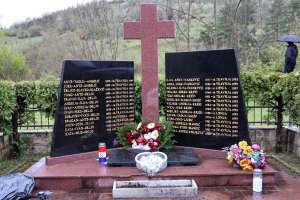BANJA LUKA, November 17 (FENA) - Around 5.000 people in the 1990s went through the notorious Manjača concentration camp, located near Banja Luka, and the exact number of those who did not survive the indescribable torture is unknown. Today at this place, nothing indicates that all those who did not belong to the Serbian people were tortured for years here.
BiH War Camp Detainees Association, Regional Association of War Camp Detainees of the Banja Luka region and the Association of War Camp Detainees of the Una-Sana Canton marked the 27th anniversary of the closure of Manjača camp yesterday at the site of the former concentration camp.
President of the BiH War Camp Detainees Association Jasmin Mešković addressed the families of killed and deceased detainees and said that it is important to testify together about their fates, suffering and torture so that the victims of Manjača camp and all other camps in BiH will never be forgotten.
He spoke of the necessity of adopting a law on victims of torture in BiH, expressing disappointment that the law would not be adopted in the near future.
"The detainees have a lot to say, but unfortunately there is no one to tell," Mešković said.
Republika Srpska Vice President Ramiz Salkić said that Manjača camp is one of many places in the entity where systematic, organized and planned torture, killing, imprisonment and abuse of those who were not followers of the criminal idea and policies and those who opposed such an idea.
Former Manjača detainee Mehmed Begić said that he remained at the camp with the will of evil men.
"We came here to testify the truth and to tell the world - that we do not have a hint of hatred," Begić said.
Manjača concentration camp was formed at the military training ground near Banja Luka in 1991. Initially, it served for imprisonment of captured Croats from battlefields in the Republic of Croatia, and after the outbreak of aggression in Bosnia and Herzegovina it served for imprisonment of Bosniak and Croat detainees from Sanski Most, Ključ, Prijedor, Kotor Varoš, Doboj, Mrkonjić Grad, Šipovo, Banja Luka.
The detainees were kept in this camp in extremely inhumane conditions, in barns that had previously been used for animals. They were beaten and abused on a daily basis, given quantities of water and food barely sufficient for survival, forced into labor. Several detainees were brutally killed in this camp, and mass graves were found at the site, where the bodies of those killed were hidden from the world.
About 5.000 civilians were held at the camp. Most senior and minor detainees were released on November 14, 1992 from the Manjača camp. A month later, the camp was closed down, a number of inmates were exchanged, while a number of inmates were transferred to the Batković camp near Bijeljina. Shortly thereafter, the Manjača camp was re-formed and operated until 1996.
For war crimes, including those committed in Manjača camp, before the International Criminal Tribunal for the former Yugoslavia in The Hague, the Court of BiH, the Split and Zagreb County Courts and the Banja Luka District Court eight people were sentenced. Milomir Stakić was sentenced for 40 years in prison, Radoslav Brdjanin 30 years, Nikola Kovačević 12 years, Mirko Graorac 15 years, Dane Lukajić six years, Željko Bulatović 11 years, Siniša Teodorović eight years and Zoran Gajić for six years.
(FENA) A. B.










